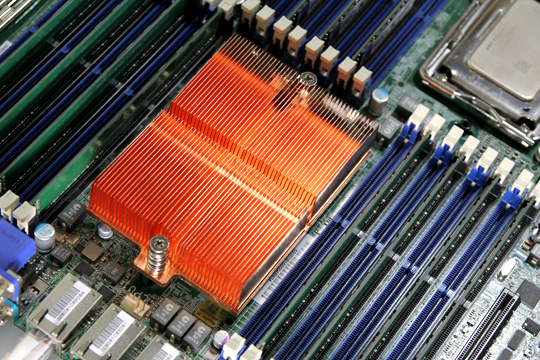Today we are benchmarking a dual AMD Opteron 6276 server to add a 32 core system to our test results. The AMD Opteron 6276 is a “sixteen core” Interlagos processor. That means it comes fully equipped with 16MB of L3 cache and 16MB of L2 cache. The chip is built on AMD’s 32nm process. Even with all this die area it has a TDP of 115w. At the time of this writing AMD has released the AMD Opteron 6300 series, however, we did want to provide data points to potential buyers. Like both the Opteron 6100 and 6300 series processors, the AMD Opteron 6200 series utilizes the 1944 pin AMD socket G34.
The Interlagos architecture AMD Opteron 6200 series came in 12 and 16 core flavors. The 12 core chips replaced the Opteron 6100 series 8 core designs. Likewise the 16 core chips replaced the Opteron 6100 series 12 core design. Despite the die shrink, performance was generally about on par with the older Magny Cours Opeterons. One area where the Opteron 6200 series did excel is in is adding both AES accelleration on-die. The other major point with these chips is that the AMD model is to allow a user to populate up to four sockets with the same SKU making the chips very cost-effective in the 4P market.
Test Configuration
We are using our updated test configuration for this benchmark session. The new configuration has 64GB of RAM and is using full retail silicon.
- CPUs: 2x AMD Opteron 6276
- Motherboard: ASUS KGPE-D16
- Memory: 8x 8GB Kingston 1600MHz RDIMMs
- SSD: 2x Samsung 840 Pro 256GB
- Power Supply: Corsair AX850 850w 80 Plus Gold
- Chassis: Norco RPC-4220
- Operating System: Ubuntu 12.04 LTS
Overall this ended up being a nice test platform and is certainly a favorite. This is the same setup we used for the AMD Opteron 6234 benchmarks.
Dual AMD Opteron 6276 Linux Benchmarks
Our Linux CPU test suite combines both single threaded and multi-threaded benchmarks. As we expect, in some of the tests the dual AMD Opteron 6276 performs worse than inexpensive single socket, higher frequency processors. These chips are meant for high-end servers where many threads will be running simultaneously. Still, it is important to see performance from both angles.
Hardinfo Performance
hardinfo is a well known Linux benchmark that has been around for years. It tests a number of CPU performance aspects.
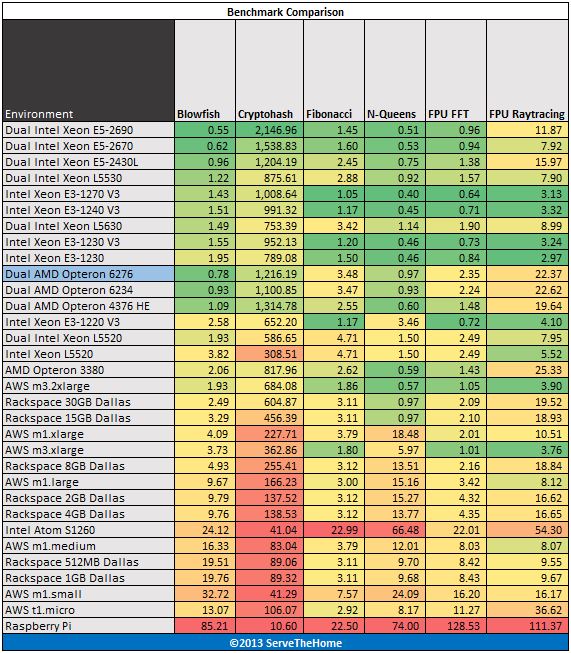
Here we see that the dual AMD Opteron 6276 performs overall fairly well against competitive systems. There are certainly some gains over the Opteron 6234 but not a landslide victory. The 16 core chips to throttle a bit faster than the 12 core chips in general due to additional heat sources.
UnixBench 5.1.3 Performance
UnixBench may be a defacto standard for Linux benchmarking these days. There are two main versions, one that tests single CPU performance on that tests multiple CPU performance. UnixBench segments these results. We run both sets of CPU tests. Here are the single threaded results:
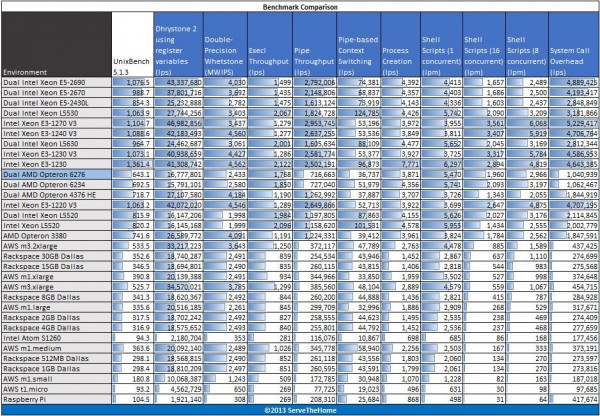
In single threaded tests, the Interlagos architecture struggles. AMD has greatly increased the IPC of their newer chips which helps a lot.
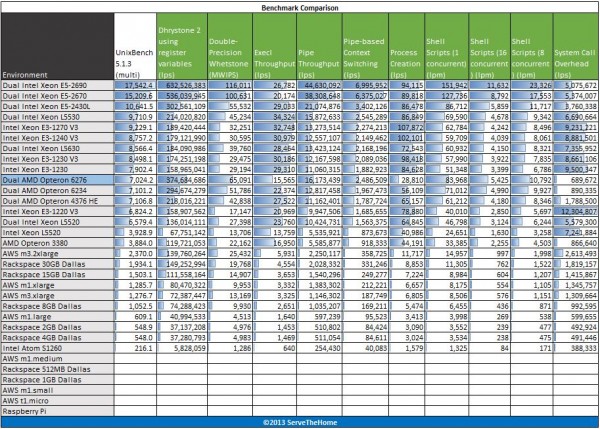
On the multi-threaded front, in many tests the dual AMD Opteron 6276 performed very well. On the other hand, there are a few results that seem below par. The results were consistent over our five runs but do bring down the overall multi-threaded score more than we would expect.
c-ray 1.1 Performance
c-ray is a very interesting ray tracing benchmark. It provides both consistent results and some clear separation. Ray tracing is generally a great multi-threaded CPU benchmark. For this test we use both a simple 7500×3500 render and a more complex 1920×1200 render. Here are the results:
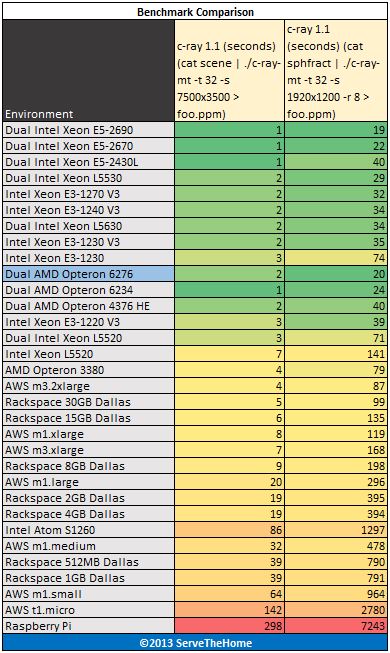
c-ray 1.1 is a very processor intensive benchmark and we see the AMD Opteron 6276 processor perform very well. It posts results just between the Intel Xeon E5-2670 and Intel Xeon E5-2690 processors. Note, the benchmark is sorted based on UnixBench results.
Crafty Chess Performance
Crafty is a well known chess benchmark. It is also one where we saw issues last time with the Phoronix Test Suite and running on ARM CPUs. Here are the Crafty Chess results from simply running “crafty bench”:
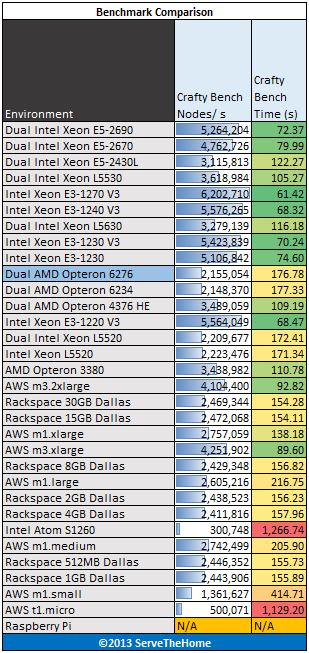
We are using the single-threaded Crafty chess benchmark here and even with the massive L3 cache, the AMD Opteron 6200 series struggles. We expected this given our previous benchmark results. Here the dual AMD Opteron 6276 is not able to fill its wide pipelines.
Phoronix Test Suite Performance
We are using four tests from the Phoronix Test Suite: pts/stream, pts/compress-7zip, pts/openssl and pts/pybench.
- STREAM by John D. McCalpin, Ph.D. is a very well known memory benchmark benchmark. S
- 7-zip compression benchmarks were a mainstay in our Windows suite so we are including it again on the Linux side as a compression benchmark.
- The pts/openssl benchmark is very dependent on the CPU architecture being used
- Python is a widely used scripting language and pyBench is a nice single-threaded Python benchmark.
Here are the results of the Phoronix Test Suite benchmarks:
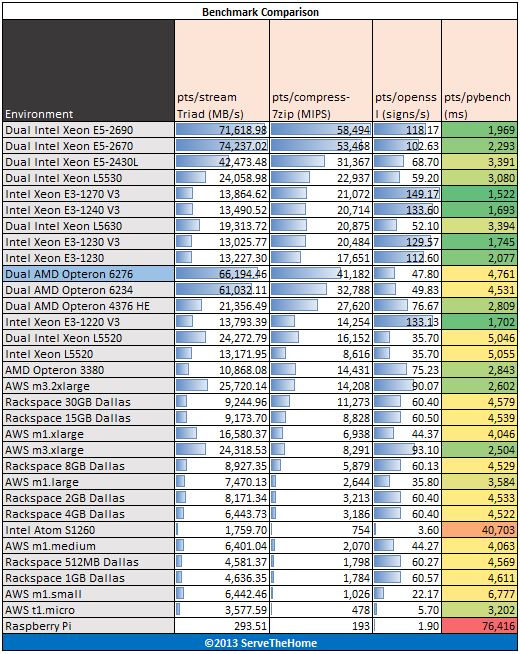
In our PTS benchmarks we see a very mixed performance picture. In terms of memory bandwidth and compression algorithm performance the chips perform well and the additional cores are clearly working. On the single threaded tests we again see the 32-core (or 16 module) dual AMD Opteron 6276 struggle.
Conclusion
AMD’s platforms are clearly the best value in 4-way systems. Unlike Intel, AMD does not charge a premium to build those kinds of massive systems. On ebay, these used processors sell for under $500 each. That means one can put together two processors and possibly a chassis and motherboard for the cost of a single Intel Xeon E5-2670. There is clearly value in the platform. The big question a potential buyer must weigh is whether it makes sense to invest in AMD socket G34 at this point versus one of Intel’s platforms.

